Hamas reportedly killed the head of a local clan in Gaza City on March 13 likely as part of Hamas’ effort to reassert its authority in the northern Gaza Strip.[i] Hamas targeted the head and other members of the armed Dughmush clan amid local accusations that the clan stole humanitarian aid and cooperated with Israel.[ii] The clan responded to the killing by vowing to retaliate and declaring Hamas members and positions as “legitimate target[s].”[iii] Hamas denied reports that its forces killed the clan members.[iv]
Hamas has sought to reconstitute militarily and rebuild its governing authority in the northern Gaza Strip since Israeli forces reduced their presence there in December 2023. CTP-ISW has reported extensively on how Hamas fighters have infiltrated areas in the northern strip that Israeli forces previously cleared. Israeli Army Radio reported in January 2023 that the Israeli military establishment believes that Hamas is trying to restore its control over the civilian population in the northern Gaza Strip partly by rehabilitating local police there.[v] The Civil Police and the Hamas-controlled Interior Ministry‘s Internal Security Forces both employ fighters from the Hamas military wing.[vi] The killing of the members of the Dughmush clan further demonstrates that Hamas fighters remain present in at least some areas of the northern strip.
Hamas may be targeting political opposition as part of its effort to consolidate its power in the northern Gaza Strip. An Israeli academic reported that Hamas killed the Dughmush members after they expressed readiness to be part of a new administration in the Gaza Strip.[vii] Tension between Hamas and the Dughmush clan is not unprecedented, as they have periodically clashed since Hamas took power in the Gaza Strip in 2007. The clan reportedly has affiliations with Salafi-jihadi groups as well as organized crime and arms trading in the Gaza Strip. Hamas reportedly warned Palestinians against cooperating with Israel earlier this week and that Hamas would treat those who did with “an iron fist.”[viii] Hamas has a long history of violently suppressing political opposition in the Gaza Strip.[ix]
Hamas’ killing of the Dughmush clan members risks further eroding the security situation there as humanitarian aid enters the northern Gaza Strip. US Secretary of State Antony Blinken said on March 13 that “criminal gangs” and “ordinary civilians” are resorting to looting humanitarian aid.[x] He warned that lawlessness, insecurity, and desperation remain hurdles to delivering aid to Gazans. Intercommunal violence within the Gaza Strip between Hamas and clans, such as the Dughmush, could further threaten the secure delivery of aid into the area. These challenges could become particularly acute if Hamas and its rivals compete with one another to control the flow of aid in the strip. Israel is currently deciding whether to open a crossing directly into the northern Gaza Strip based on as assessment of how securely the convoys can reach civilians.[xi]
Key Takeaways:
- Northern Gaza Strip: Hamas reportedly killed the head of a local clan in Gaza City likely as part of Hamas’ effort to reassert its authority in the northern Gaza Strip.
- Southern Gaza Strip: Israeli forces continued to conduct clearing operations in several sectors of Khan Younis.
- Political Developments: Palestinian Authority (PA) President Mahmoud Abbas appointed the current chairman of the Palestinian Investment Fund, Mohammad Mustafa, as the new PA prime minister. Abbas tasked him with forming a new government that will seek to rebuild the Gaza Strip after the war.
- Yemen: The Houthi movement launched an anti-ship ballistic missile targeting an unspecified vessel in the Red Sea. US CENTCOM reported that US forces destroyed four drones and a surface-to-air missile in Houthi-controlled areas of Yemen.
- Iraq: Head of the Iraqi National Masses Party Ahmed Abdullah al Jubouri nominated Badr Mahmoud al Fahal for governor of Salah ad Din Province.
- West Bank: Israeli forces have clashed with Palestinian fighters at least five times in the West Bank.
- Southern Lebanon and Golan Heights: Lebanese Hezbollah has conducted at least five attacks from southern Lebanon into northern Israel.
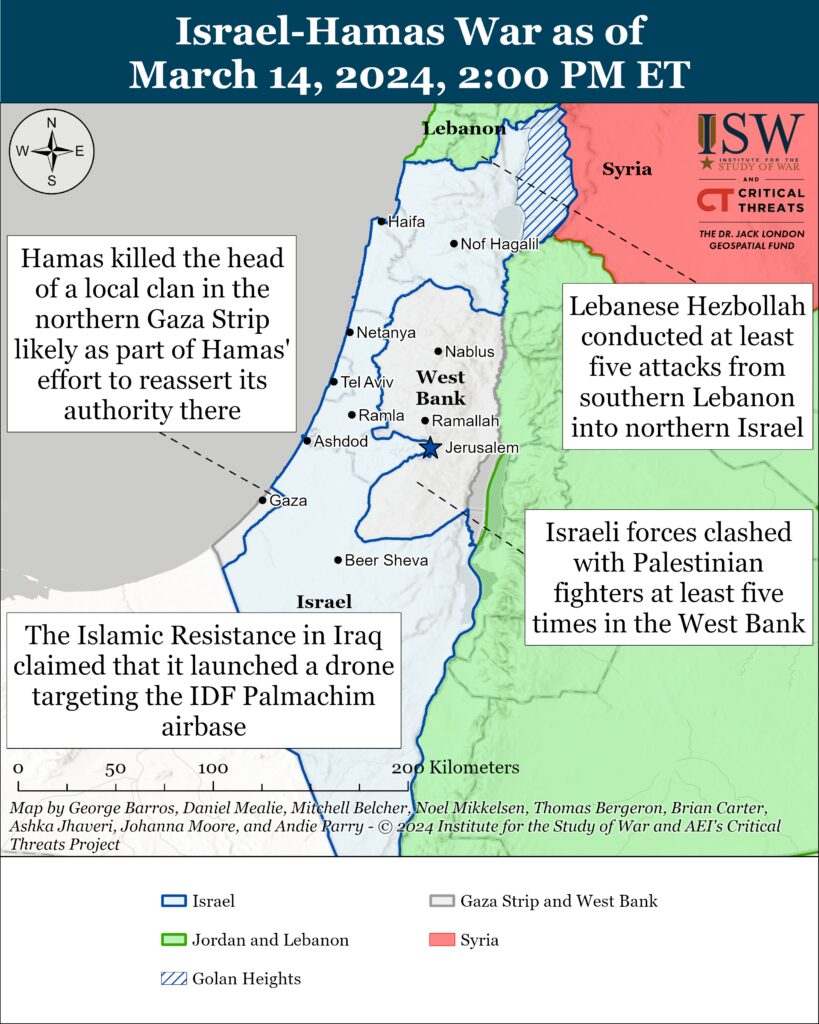
Gaza Strip
Axis of Resistance campaign objectives:
Erode the will of the Israeli political establishment and public to launch and sustain a major ground operation into the Gaza Strip
Degrade IDF material and morale around the Gaza Strip.
The IDF 162nd Division engaged Palestinian fighters in the central Gaza Strip on March 14. The IDF Nahal Brigade (162nd Division) attacked a nearby Palestinian militia cell with tank fire.[xii] The IDF Air Force separately conducted an airstrike targeting a Palestinian fighter.[xiii]
Israeli forces continued to conduct clearing operations in several sectors of Khan Younis on March 14. The IDF 7th Brigade (36th Division) located a three-man Palestinian militia cell in Bani Suheila, eastern Khan Younis, and directed tank fire targeting them.[xiv] The IDF LOTAR counterterrorism unit conducted “special and targeted” missions in Khan Younis and raided several Hamas-affiliated military buildings.[xv] The IDF Givati Brigade (162nd Division) raided buildings and destroyed rocket launchers in Hamad, northern Khan Younis.[xvi] The Democratic Front for the Liberation of Palestine, which is a leftist-Palestinian militia aligned with Hamas in the war, clashed with Israeli forces in Hamad.[xvii] Israeli forces initially expanded clearing operations to the neighborhood on March 3.[xviii]
The Israeli Army Radio cited an IDF lieutenant colonel on March 14 saying that Israeli forces have engaged “high-quality” members of Hamas’ elite Nukhba force in Hamad.[xix] The IDF officer highlighted that the Palestinian fighters are working in organized cells with a structured command system. He also noted that Israeli forces encountered the highest concentration of Palestinian snipers in Hamad. There have been at least three clashes between Israeli forces and Palestinian fighters daily since Israeli forces advanced into the neighborhood, which is a small part of Khan Younis.
The IDF said on March 13 that it plans to move civilians from Rafah to “humanitarian enclaves” in the central Gaza Strip before any Israeli offensive into Rafah.[xx] There are approximately 1.4 million displaced Palestinian civilians currently in Rafah.[xxi] The Israeli government has been clear on its intentions to expand clearing operations into the Central and Rafah Governorates.[xxii] The IDF spokesperson said that Israel would work with the international community to provide civilians with food, temporary housing, and establish field hospitals in the “enclaves.” The spokesperson noted that Israel would advance into Rafah depending on ideal, unspecified conditions.
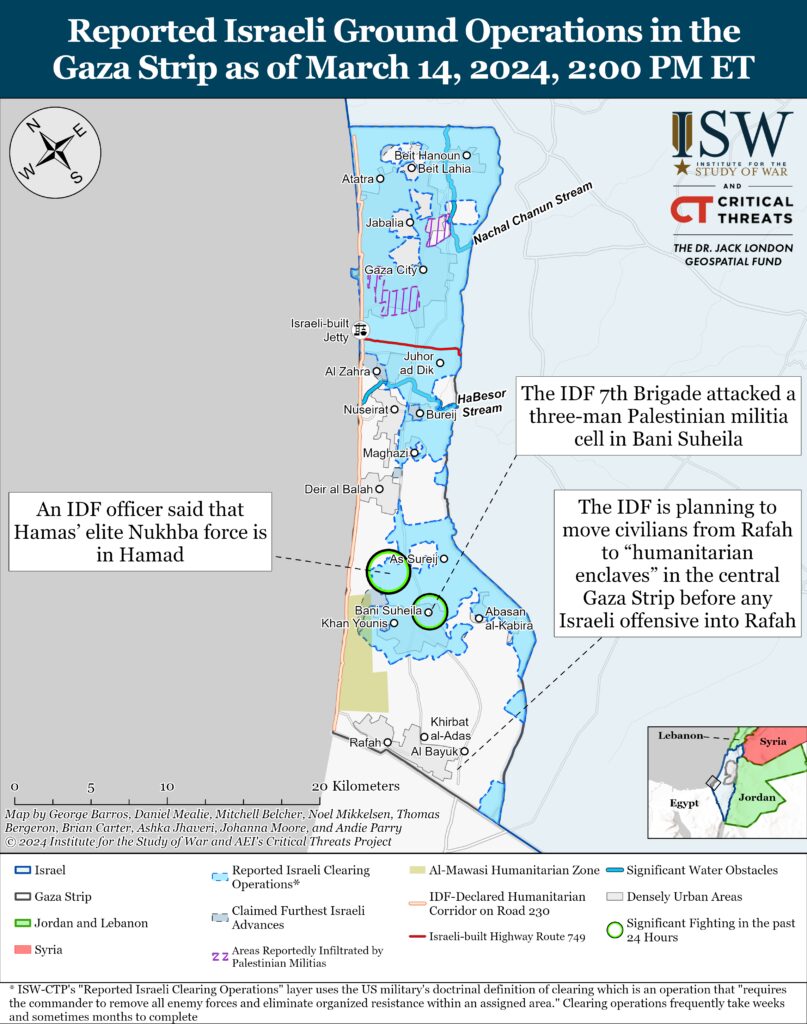
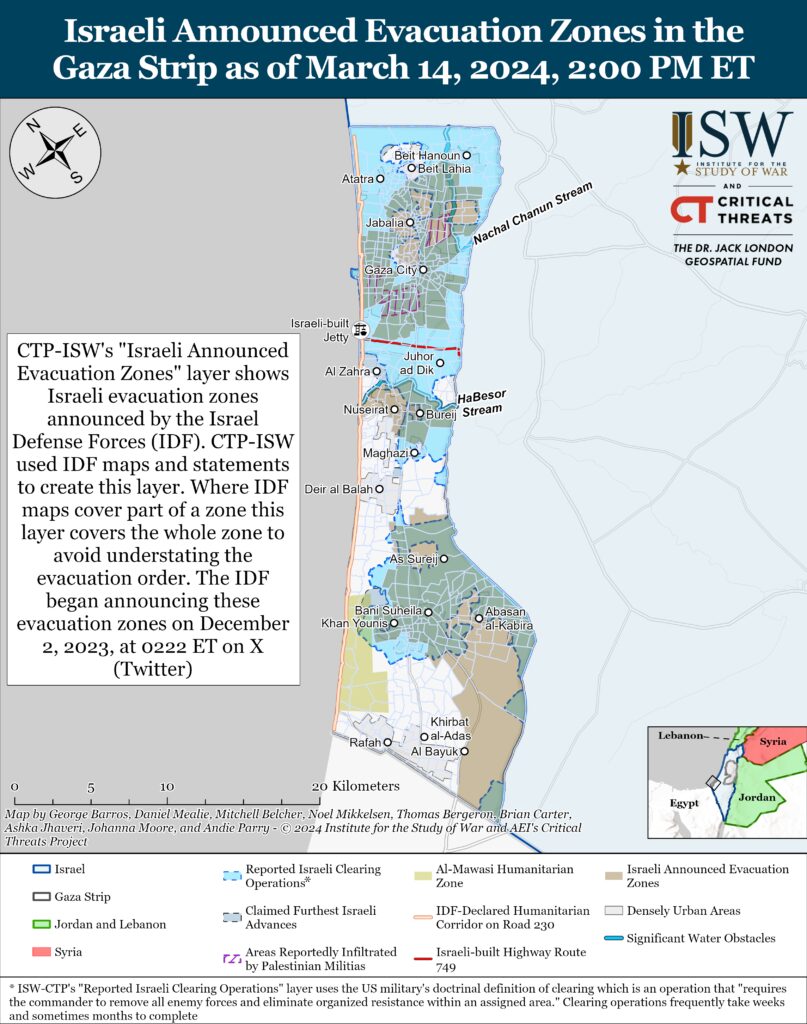
The IDF confirmed on March 14 that it is preparing for the arrival of humanitarian aid via the maritime corridor to the Gazan coast.[xxiii] The first ship of its kind left Cyprus on March 12, towing a barge containing food from the World Central Kitchen organization, funded by the United Arab Emirates and Cyprus.[xxiv] The IDF said that the shipment is happening in coordination with the Israeli defense establishment and Defense Ministry.[xxv] Maxar published satellite imagery captured on March 14 that reveals the new jetty under construction on the coastline in southern Gaza City. The jetty is also north of the IDF-constructed road splitting the northern and central Gaza Strip.[xxvi]
The IDF said senior US military officials will visit Israel in the coming days to coordinate the construction and protection of a temporary pier to facilitate aid shipments into the Gaza Strip.[xxvii] Israel said that they will discuss protecting the pier from potential Hamas attacks.[xxviii] US CENTCOM announced on March 9 that a US Army logistics support vessel departed from Virginia to the Eastern Mediterranean Sea with the first load of equipment to establish a temporary pier to deliver humanitarian supplies to the Gaza Strip.[xxix]
Palestinian Authority (PA) President Mahmoud Abbas appointed the current chairman of the Palestinian Investment Fund, Mohammad Mustafa, as the new PA prime minister on March 14. Abbas tasked him with forming a new government that will seek to rebuild the Gaza Strip after the war.[xxx] Mustafa is a longtime adviser to Abbas and is also tasked with facing mounting pressure to reform the PA.[xxxi] Former PA Prime Minister Mohammad Shtayyeh announced his cabinet’s resignation in late February amid calls for leadership changes.[xxxii] His replacement follows the PA and Palestinian Liberation Organization (PLO) indicating that they may reform themselves and are trying to unify Palestinian factions, including Hamas.[xxxiii] An unspecified source with direct knowledge stated that Qatar urged Abbas to appoint Hamas-accepted individuals to the new government, which Abbas apparently rejected.[xxxiv]
An Arab-Israeli citizen killed one individual and injured three others, including an IDF soldier, in a stabbing attack in southern Israel.[xxxv] The IDF shot and killed the perpetrator.[xxxvi] Israeli media identified the perpetrator as Fadi Abu Altyaf, who lived in the Gaza Strip until moving to Israel in 2019.[xxxvii] A Palestinian militia praised Altyaf for his attack, although no militia has claimed affiliation with him at the time of this writing.[xxxviii]
The IDF reported that Palestinian fighters attempted to launch mortars into Israeli territory from the central Gaza Strip targeting a town in southern Israel on March 13.[xxxix] The fighters targeted Nahal Oz in southern Israel, and but the mortars fell near the Gaza Strip.[xl] The IDF identified the Palestinian militia cell responsible for the attack in the northern Gaza Strip and directed an airstrike targeting them.
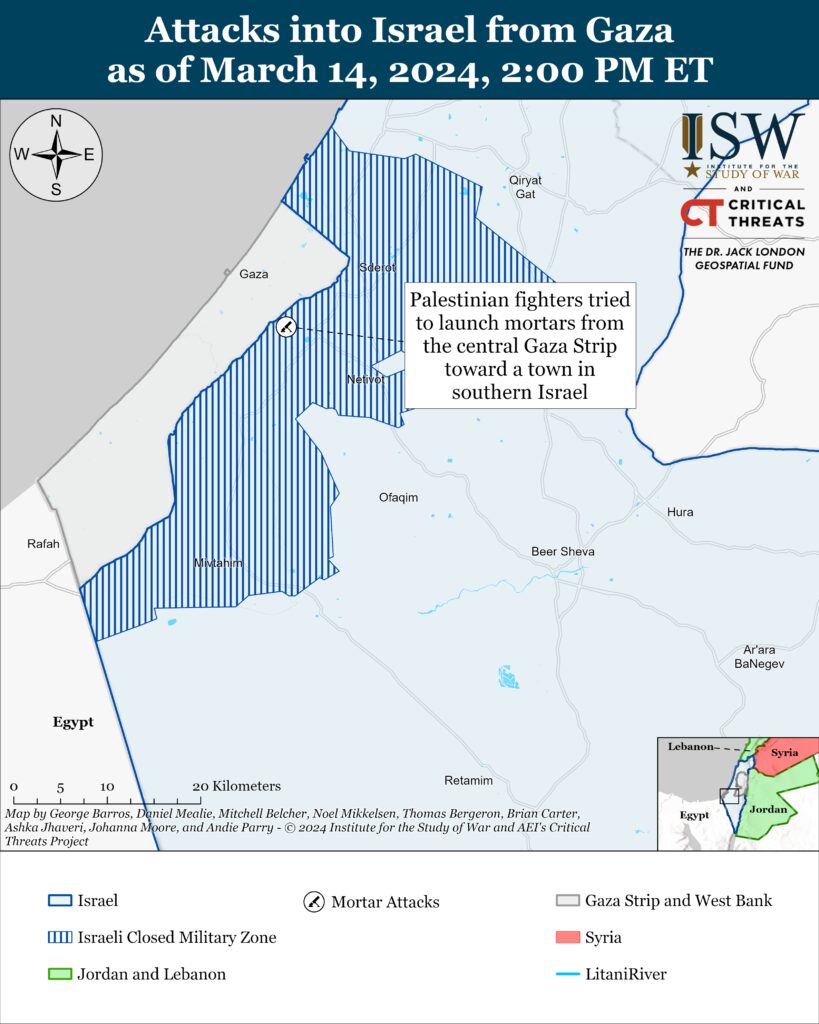
Recorded reports of attacks; CTP-ISW cannot independently verify impact.
West Bank
Axis of Resistance campaign objectives:
Draw IDF assets and resources toward the West Bank and fix them thereIsraeli forces have clashed with Palestinian fighters at least five times in the West Bank since CTP-ISW’s last data cutoff on March 13.[xli] PIJ and the al Aqsa Martyrs’ Brigades detonated IEDs and fired small arms targeting Israeli forces who were conducting raids in Nablus on March 13.[xlii] Israel forces detained 13 wanted individuals as part of a “brigade operation to counter terrorism in Jericho” in the West Bank.[xliii]
Hamas reiterated its call for Palestinians and Israeli Arabs to “defend” al Aqsa Mosque ahead of the first Friday of Ramadan on March 15.[xliv] Hamas previously called on March 9 and 13 for Palestinians to escalate attacks targeting Israeli forces during Ramadan.[xlv] Hamas encouraged Palestinians to, “remain there for days and nights.”[xlvi]
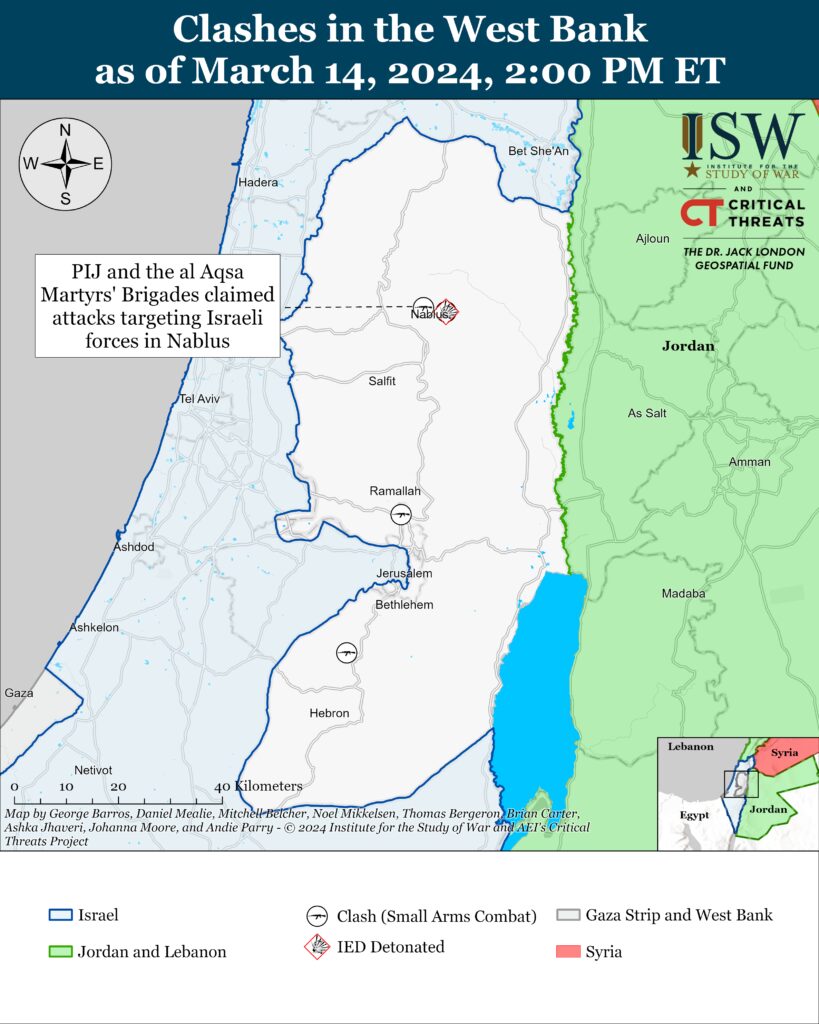
This map is not an exhaustive depiction of clashes and demonstrations in the West Bank.
Southern Lebanon and Golan Heights
Axis of Resistance campaign objectives:
Draw IDF assets and resources toward northern Israel and fix them there
Set conditions for successive campaigns into northern IsraelLebanese Hezbollah has conducted at least five attacks from southern Lebanon into northern Israel since CTP-ISW’s last data cutoff on March 13.[xlvii] Hezbollah claimed that it conducted attacks targeting Israeli military positions in al Malikiyah and on Karantina hill along the Israel-Lebanon border.[xlviii] Hezbollah also claimed attacks targeting two Israeli military positions in Shebaa Farms.[xlix]
The IDF Air Force intercepted near Kafr Blum a drone that an unspecified actor launched from Lebanon into Israel.[l]
The Islamic Resistance in Iraq—a coalition of Iranian-backed Iraqi militias—claimed that it launched a drone targeting the IDF Palmachim airbase on March 13.[li] The group released a video showing the launch of at least one drone.[lii] CTP-ISW cannot verify whether the attack occurred or struck its intended target. Neither Israeli media or officials have acknowledged any attack at the time of this writing.
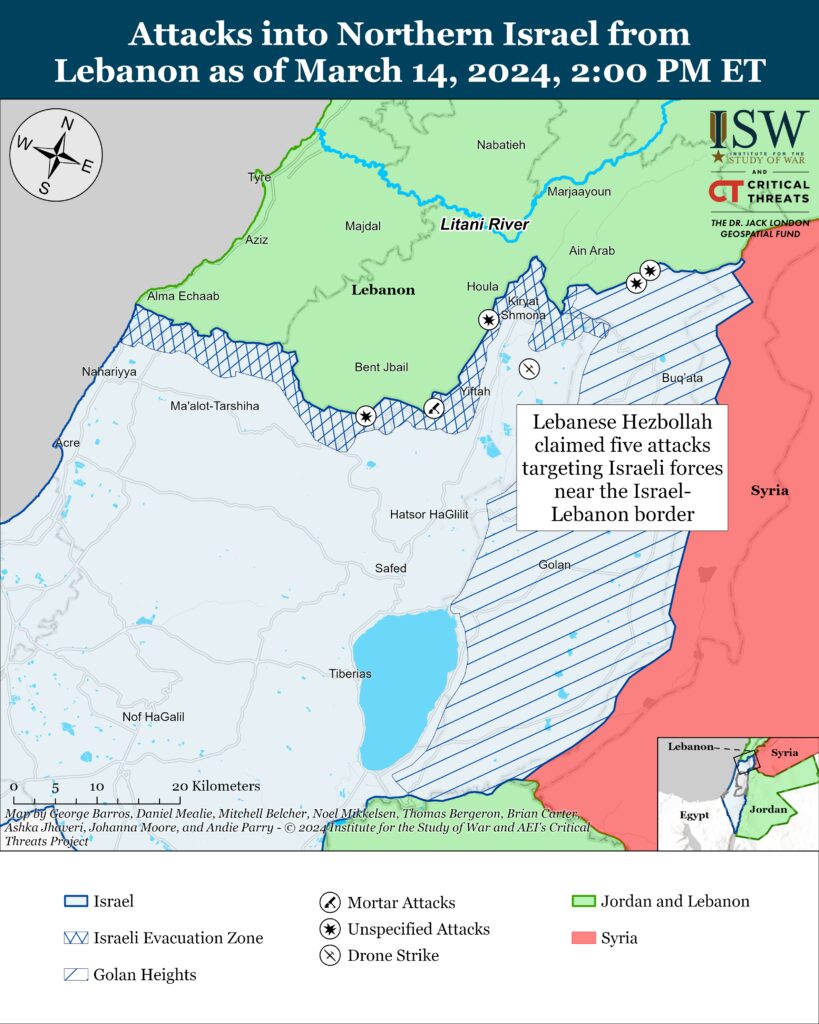
Recorded reports of attacks; CTP-ISW cannot independently verify impact.
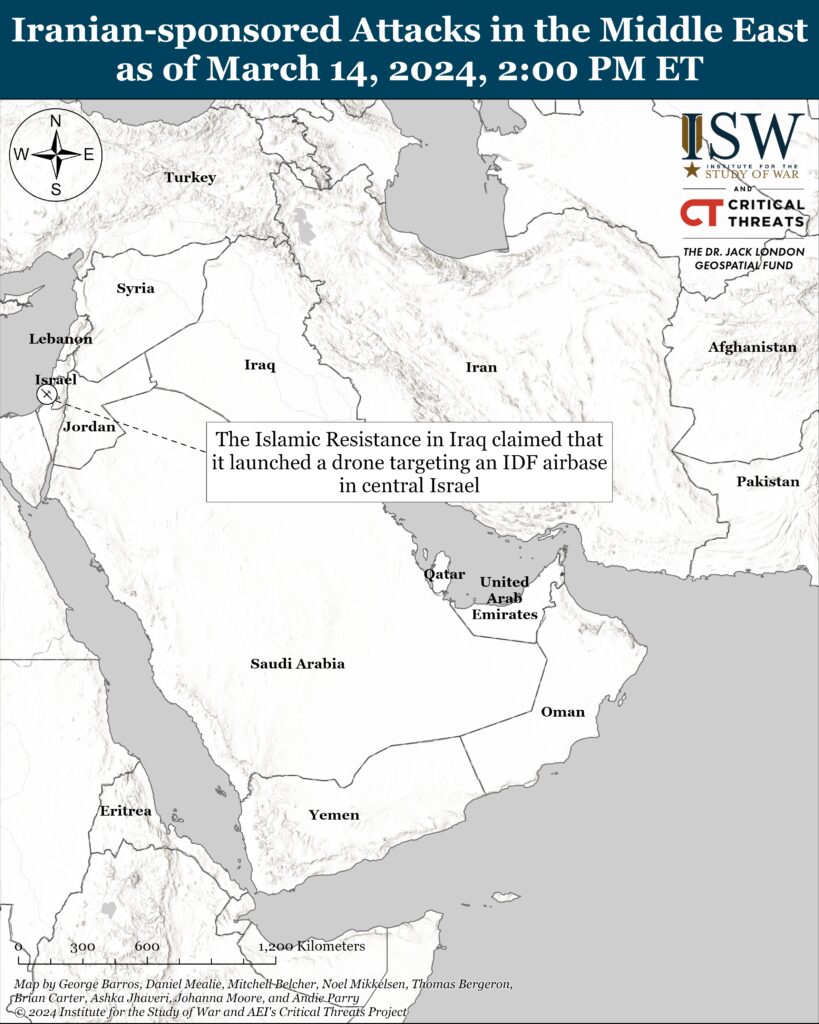
Recorded reports of attacks; CTP-ISW cannot independently verify impact.
Iran and Axis of Resistance
Axis of Resistance campaign objectives:
Demonstrate the capability and willingness of Iran and the Axis of Resistance to escalate against the United States and Israel on multiple fronts
Set conditions to fight a regional war on multiple frontsHead of the Iraqi National Masses Party Ahmed Abdullah al Jubouri nominated Badr Mahmoud al Fahal for governor of Salah ad Din Province on March 14.[liii] Fahal is a member of the Accountability and Justice Commission that the Shia Coordination Framework – a coalition of loosely aligned pro-Iranian political parties – has weaponized to sideline political opposition.[liv] The National Masses Party won five of the 15 provincial seats in Salah ad Din Province.[lv]
Iraqi President Abdul Rashid previously rejected Jubouri for governor of Salah ad Din Province in February 2024, citing a 2008 law, which bars convicted felons from holding office.[lvi] Jubouri was convicted in 2017 for abusing his role as governor of Salah ad Din Province, misusing federal funds, and appropriating lands for personal use.[lvii] The US Treasury Department sanctioned Jubouri in 2019 for corruption, including the misappropriation of funds and government resources for personal benefit.[lviii] The Treasury Department reported that Jubouri has also ”accomodat[ed]” Iranian-backed Iraqi militias to secure personal interests.
Russian state media claimed on March 14 that the Houthis successfully tested an unspecified hypersonic missile and that the group is preparing to use this missile as part of its attacks targeting international shipping and Israel.[lix] The Houthis have used ballistic missiles that travel at hypersonic speeds, defined as greater than Mach 5, but it is extremely unlikely that the Houthis possess working hypersonic glide vehicles.[lx]
The Houthi movement launched an anti-ship ballistic missile targeting an unspecified vessel in the Red Sea on March 13.[lxi] US CENTCOM reported that the missile did not impact any ship or cause damage or injuries.
CENTCOM reported on March 13 that US forces destroyed four drones and a surface-to-air missile in Houthi-controlled areas of Yemen.[lxii]
Houthi-controlled media claimed that the United States and United Kingdom conducted four airstrikes targeting Bayt al Faqih, near Hudaydah, and Hudaydah International Airport on March 14.[lxiii]
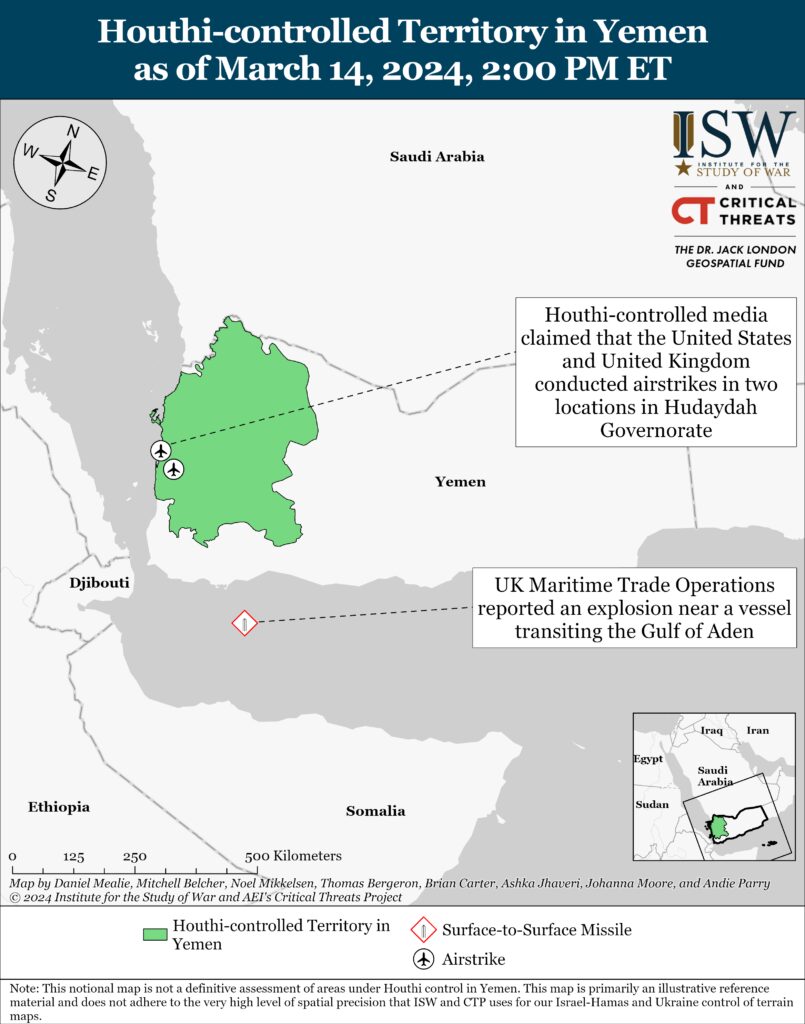
The Financial Times reported that the United States held secret, Oman-brokered talks with Iran in January 2024 to convince Tehran to pressure the Houthis to stop attacking ships in the Red Sea.[lxiv] White House Middle East adviser Brett McGurk and acting Special Envoy for Iran Abram Paley led the American delegation. Iranian Deputy Foreign Affairs Minister for Policy Ali Bagheri Kani led the Iranian delegation. Iranian state media denied the report, citing an ”informed” source.[lxv]
 Eurasia Press & News
Eurasia Press & News

